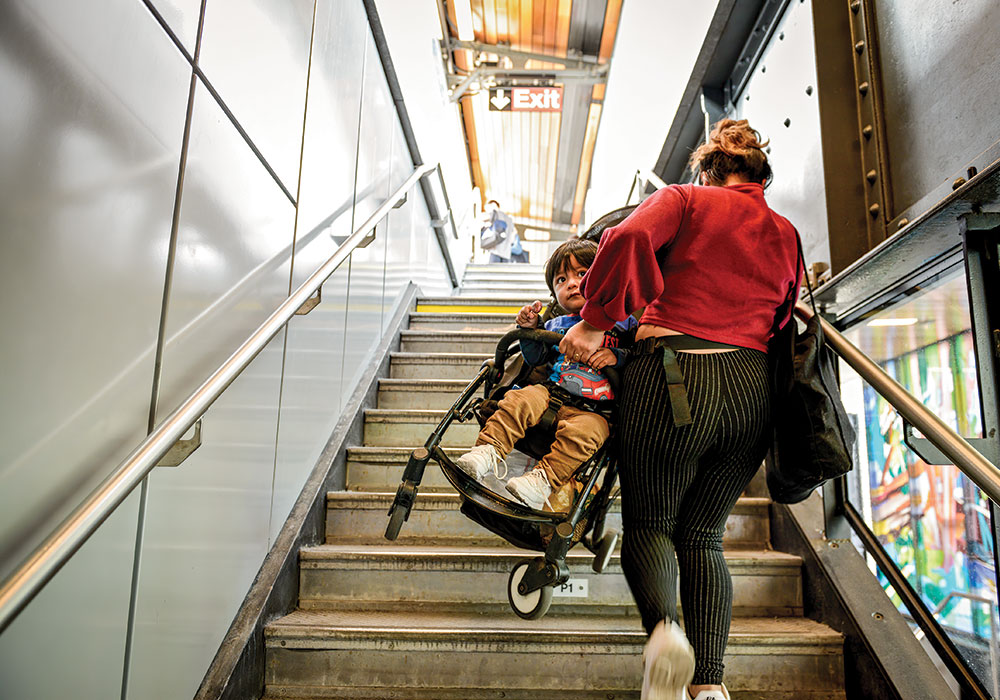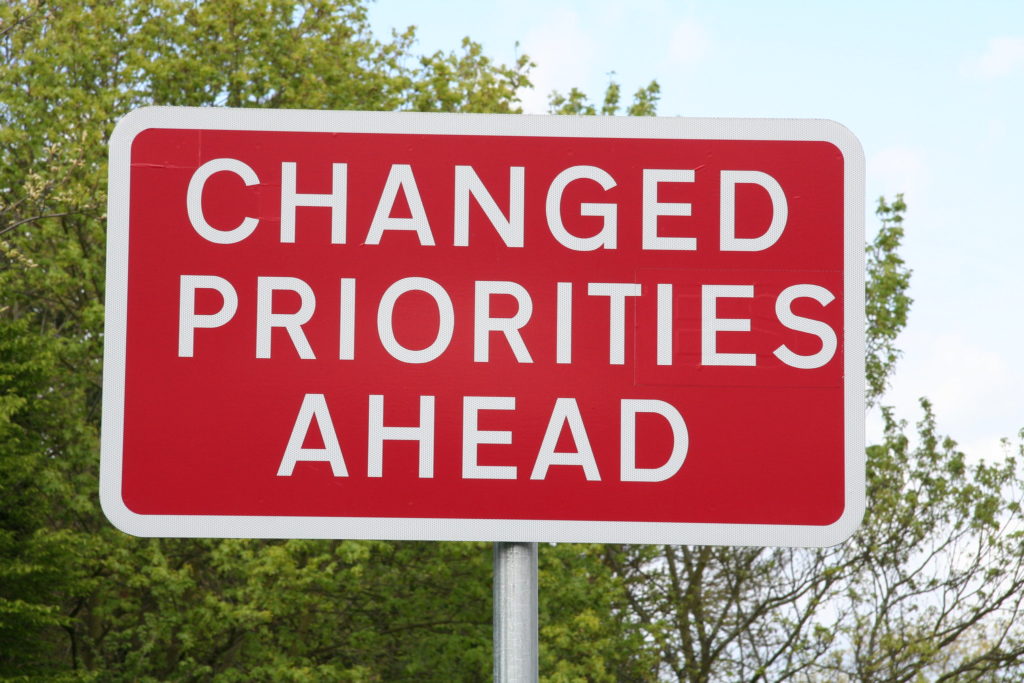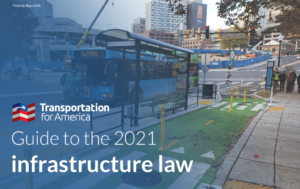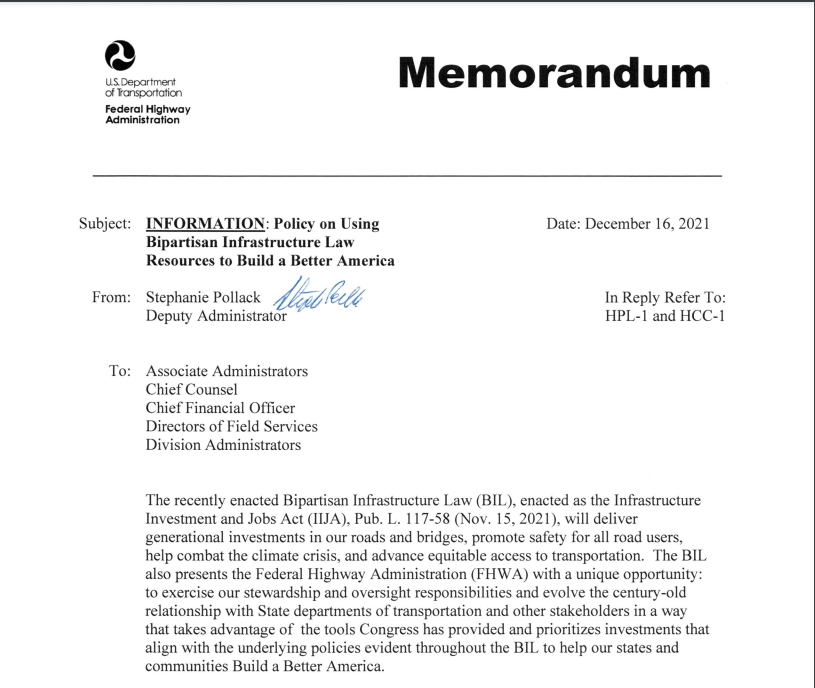
USDOT urges states to prioritize repair, safety, and climate with their influx of infrastructure bill cash


Although state DOTs have always been free to prioritize repair, safety, or improving access for everyone across the entire system, most have traditionally chosen to use that flexibility to build new highways instead. With state DOT coffers soon to be loaded with billions from the new infrastructure bill, USDOT is urging states via a new memo to focus on their repair needs, take an expansive view of what they can invest in, and invest in reducing emissions and improving safety.
This post is part of T4America’s suite of materials explaining the 2021 $1.2 trillion Infrastructure Investment and Jobs Act (IIJA), which governs all federal transportation policy and funding through 2026. What do you need to know about the new infrastructure law? We know that federal transportation policy can be intimidating and confusing. Our hub for the new law will walk you through it, from the basics all the way to more complex details.
Last week USDOT finally released the long awaited state formula funding apportionment tables, which document how the first year of the infrastructure law’s formula funding will be divided up to the states. When it comes to the FHWA and FTA’s role in the oversight and messaging on formula funding to the states, the experience has not been consistent, which this memo looks to tackle.
FHWA sends a clear and consistent guiding message
With the funding amounts published, the Federal Highways Administration (FHWA) followed up the next day with a notable and perhaps unprecedented memo of administrative guidance from Deputy Administrator Stephanie Pollock directed to FHWA headquarters administrators, division administrators, and their teams. This memo sent a clear message on where USDOT wants to emphasize its technical assistance and oversight of federal transportation program funds.
Here are four points the Deputy Administrator made that we want to highlight:
1) Prioritizing repair and rehabilitation first
Since Congress chose not to prioritize repair by discarding the House’s INVEST Act which would have instituted hard and fast requirements, USDOT and the Biden administration want to emphasize the critical need for improving the state of repair of the transportation infrastructure. The guidance reminds the role states must play in maintaining a state of repair of their existing infrastructure (23 USC 116) if they plan to participate in the federal transportation program. Lastly, in advancing maintenance, FHWA encourages incorporation of safety and multimodal accessibility into the repair scope of the infrastructure project.
2) Prioritizing investment on all federal-aid transportation infrastructure
The memorandum makes note that the formula funding being directed to states is not for exclusive use of state DOT-owned and managed infrastructure and that they should consider all the needs in their state—not just the big ticket state-owned highways where many typically focus their funds. The memo notes that the 50,000 miles of state DOT-owned roads and bridges are in much better condition than the one million miles of other roads not owned by the state but eligible for that funding, 85 percent of all miles driven takes place on these other roads/bridges, and formula programs also have money dedicated to these “off-system” roads and bridges.
3) Simplifying project review
The memorandum guides FHWA to help fast track and simplify the review of projects that prioritize repair, improve safety, or invest in multimodal improvements. Streetsblog summed up this provision well last week:
Among the most potentially transformative new guidelines is a federal advisory that multimodal projects, like bike lanes, sidewalks and BRT lanes, should no longer be subjected to onerous environmental review — and that highway expansions and other high-polluting projects for which the National Environmental Protection Act was created should be scrutinized much more heavily than they are now. Opponents of sustainable transportation across the country have long abused the environmental review process to stall carbon-cutting projects, while letting autocentric efforts sail through.
4) Emphasizing operational efficiency over expansion
The memo says that FHWA will do what they can with their technical assistance and oversight to emphasize operational efficiencies to move more people and goods within existing infrastructure over capacity expansion (i.e, new highways). The memorandum acknowledges that FHWA is in no position to prohibit states from expanding system capacity, but that FHWA will explore all policy mechanisms at their disposal to not only strongly encourage and influence, but require an emphasis on repair and alternative enhancements to roadway capacity expansion. Of special note as well, FHWA underscored the flexibility that state DOTs have and should exercise in supporting public transportation projects.
–
Though this policy memorandum does not have any enforceable mechanisms in what state DOTs can and will do with their formula highway funding, it makes a major statement about where the administration’s priorities lie, gives ammunition to the advocates trying to hold them accountable, and can help nudge and encourage states that are in the midst of attempting to change how they prioritize their spending.
Aarian Marshall wrote in Wired last week about the potential impact of this memo and what’s happening in Colorado, (where the state’s transportation commission approved a new rule requiring the state to consider the greenhouse gas impacts of their projects and try to reduce them):
The DOT’s gentle, “have you thought about this?” approach to climate-friendly and safe road infrastructure may feel toothless. But states that have experimented with similar approaches say it’s helpful. In Colorado, Governor Jared Polis has urged the state DOT to emphasize people-friendly—rather than builder-friendly—infrastructure projects. More than half of the state’s transportation money goes toward “state of good repair” projects, like filling potholes, fixing bridges and viaducts, and adding shoulders to rural roads for safety, says Shoshana Lew, executive director of Colorado’s DOT. Prioritizing safety and climate effects “forces the conversation to be more rounded,” says Lew. “It makes you think really hard about whether the project is worth it, and what the implications will be.” As a result of Colorado’s approach, she says, an expansion project on Interstate 70 will include a new van shuttle system that could grow bigger with demand.
This memo empowers USDOT representatives to the state DOTs and metropolitan planning organizations (MPOs) to be more vocal and consistent in advancing department priorities. This also gives local, regional, and state community advocates something to point to as they try to build momentum towards decision-making change in the implementation of the federal transportation program in their backyards.





